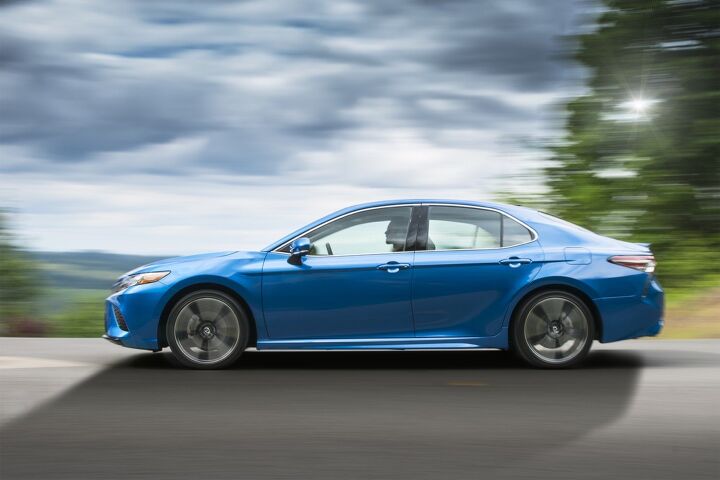Want a Truly Japanese 2018 Toyota Camry? Examine VINs Closely for the Next Few Months
As all-new 2018 Toyota Camrys begin to trickle into Toyota’s U.S. dealers over the coming weeks, take a close look at the VIN.
It’s viewable through the windshield on the driver’s side. See that first number? It’s likely a 4, which means this Camry was built in Georgetown, Kentucky.
But there’s a chance that the VIN on the new 2018 Camry sitting on your local Toyota dealer’s lot doesn’t begin with a number at all.
You’re looking at the once-coveted J-VIN. Ooh la la.
According to the Automotive News Data Center, not a single one of the new Toyota Camrys sold in the United States so far this year have been built outside of the United States — they’re all domestic cars. Reaching back over the last few years likewise reveals very few Camry imports: only 321 of the 857,961 Camrys sold in the U.S. in 2014 and 2015 were imported.
But the transition to an all-new, TNGA-based Toyota Camry at the Georgetown, Kentucky, assembly plant, the first transition Georgetown has ever done for a completely new model, is challenging. Although the Toyota New Global Architecture is intended to improve efficiency, Wards Auto reports the Kentucky factory “will take a couple steps back before it can move forward in efficiency.”
Toyota has increased the Georgetown workforce to the highest level ever in order to ease the transition to an all-new Camry, but ramping up to full capacity won’t happen overnight. And Toyota does plan to use much of the Georgetown plant’s capacity, operating under the belief that a new Camry can spur demand across the midsize segment.
Yet while Toyota increases production of the 2018 Camry in Kentucky, where the Toyota Avalon and Lexus ES350 are also assembled, dealers will also receive some 2018 Camrys from Toyota’s plant in Tsutsumi, Japan. Wards says shipments from Japan will be “dialed down” by the end of August once Toyota’s local facility is operating the way it was designed to do so.
In the meantime, for customers willing to buy a new car in its first model year, there is once again an option to source your “Japanese car” from Japan.
So there’ll be superior quality and craftsmanship? Probably not. Camrys hardly became known as reliability nightmares when U.S. production began nearly thirty years ago.
But there’s still a certain segment of the population that wants their BMWs to come from Germany and not South Carolina, who want to drive Hamtramck-built Buicks rather than China-built Buicks, and their Toyotas to come from Japan rather than Kentucky.
For that demographic, there will be a handful of Tsutsumi-built 2018 Camrys. But probably not for long.
[Images: Toyota]
Timothy Cain is a contributing analyst at The Truth About Cars and Autofocus.ca and the founder and former editor of GoodCarBadCar.net. Follow on Twitter @timcaincars.
More by Timothy Cain
Latest Car Reviews
Read moreLatest Product Reviews
Read moreRecent Comments
- ToolGuy Why would they change the grille?
- Oberkanone Nissan proved it can skillfully put new frosting on an old cake with Frontier and Z. Yet, Nissan dealers are so broken they are not good at selling the Frontier. Z production is so minimal I've yet to see one. Could Nissan boost sales? Sure. I've heard Nissan plans to regain share at the low end of the market. Kicks, Versa and lower priced trims of their mainstream SUV's. I just don't see dealerships being motivated to support this effort. Nissan is just about as exciting and compelling as a CVT.
- ToolGuy Anyone who knows, is this the (preliminary) work of the Ford Skunk Works?
- Kwik_Shift_Pro4X I will drive my Frontier into the ground, but for a daily, I'd go with a perfectly fine Versa SR or Mazda3.
- Zerofoo The green arguments for EVs here are interesting...lithium, cobalt and nickel mines are some of the most polluting things on this planet - even more so when they are operated in 3rd world countries.



































Comments
Join the conversation
I'd prefer a J-VIN Camry, but Kentucky has been building them for so long it probably doesn't matter. I'd prefer any car I buy be made in the manufacturer's country of origin, fully realizing in many cases it doesn't matter (but in some cases it does, see Mazda/Mexico mention above) If I bought a German car, the "W" VIN is preferable to me over South Africa, Mexico, or South Carolina. Same deal with Japanese, my J-VIN early 90s Hondas were fantastic. I loved that my Mustang was made at River Rouge where Model Ts and WWI boats had been made. Way cooler than Canada, "the country that invented Rock & Roll" according to GM marketing, where the Camaro was made. I even find it cool that my Elantra Sport came from Ulsan, Korea, and not Alabama.
My 1999 Accord EX with J vin has been a phenomenal car. Unlike many I have seen laden with rust mine is totally rust free. Coincidence? Not sure. But it still rides and drives like a new car some 18 years later. The only snafu with having a Japanese built car is that sometimes a part may be specific to that vin so auto parts stores can mess up if you need sonething. Other than that I say J vin all the way!!